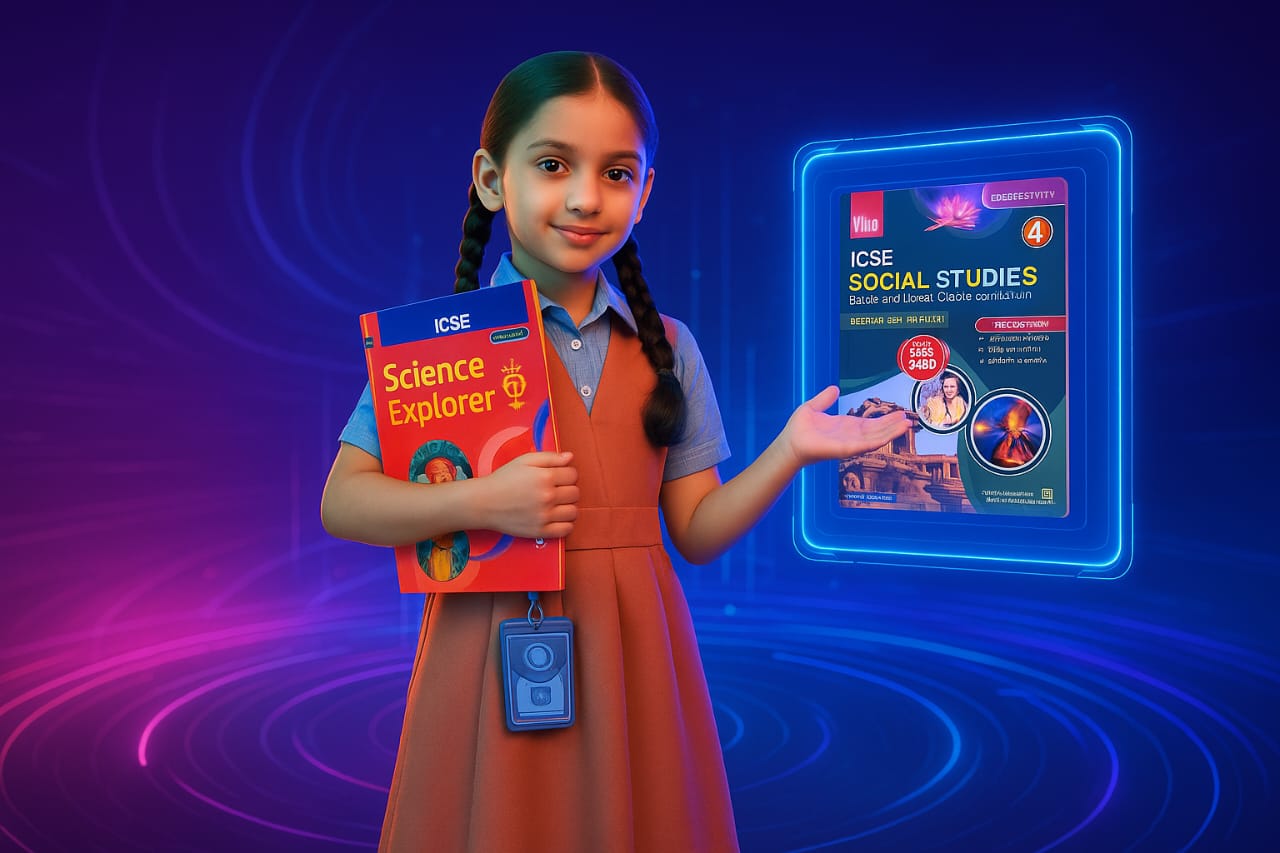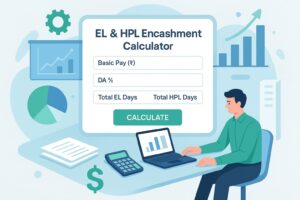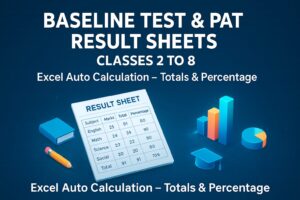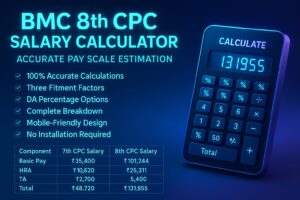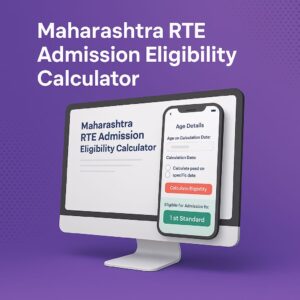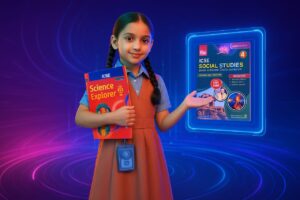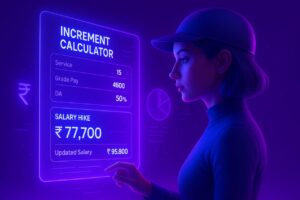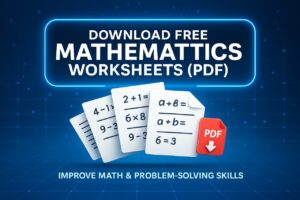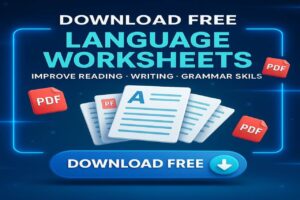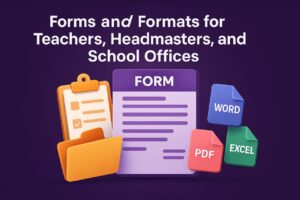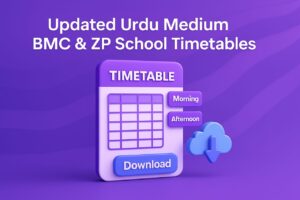Looking for solved exercises and answers for the ICSE Class 4 Social Studies Viva textbook? Get all chapter-wise questions and accurate answers based on the latest CISCE curriculum and NEP 2020 — completely free, no sign-up required. Perfect for students, parents, and teachers.
Contents
-
Click or tap on any lesson title below to expand and view the summary, key concepts, glossary, and fully solved exercises for that chapter.
1 . What is History
📘 Lesson 1: What is History?
🧠 Lesson Summary:
This lesson introduces the concept of history as a systematic study of the past. It explores the importance of learning history to understand how past events influence our present and shape our future. Students also learn about family history and the major periods in Indian history: ancient, medieval, and modern.
🎯 Learning Competencies:
By the end of this lesson, learners will be able to:
✅ Explain the meaning and purpose of studying history
✅ Understand the connection between past, present, and future
✅ Differentiate between ancient, medieval, and modern periods
✅ Identify the importance of family history and historical periods
✅ Recognize how past events impact current life
📚 Glossary (Word Bank):
| Word | Meaning |
|---|---|
| Affect | Influence |
| Outlook | Point of view |
| Clubbed | Combined or grouped together |
| Historian | A person who studies and writes about history |
| Monument | A structure built to commemorate persons/events |
📝 Exercises & Solutions:
✨ Let’s Begin Activity:
🖼️ Paste a picture of a major past event and discuss the following:
-
When did the event take place?
[Student’s personal input] -
Why do you consider it a major event?
[Student’s personal input] -
Why and how did it happen?
[Student’s personal input] -
What changes did it bring to your life?
[Student’s personal input]
💬 Time to Discuss:
🩺 Why does a doctor ask about symptoms before treatment?
Answer:
Because understanding the symptoms helps the doctor diagnose the illness accurately. Just like history helps us understand the past, these details help doctors decide the correct treatment.
📖 Do and Learn – Family History Activity:
Paternal Great-grandparents:
Example: Mr. Rahim Khan & Mrs. Amina Khan
Maternal Great-grandparents:
Example: Mr. Suresh Mehta & Mrs. Lata Mehta
🔍 Think Tank Question:
Q: How does study of history play an important role in shaping our present?
Answer:
History helps us understand why things are the way they are today. It guides decision-making, teaches us lessons from past mistakes, and prepares us for a better future.
✅ Let’s Recall – Fill in the Blanks (with answers):
-
Knowing the past helps in understanding the present and helps prepare for the future.
-
History is divided into past, present and future for easy understanding.
-
We divide history into certain parts which we call periods.
-
A period may consist of many hundreds of years.
-
Our history is broadly divided into three periods.
🎯 Apply Your Knowledge – Multiple Choice Questions:
-
Which period consists of the history of the oldest times?
✅ (c) Ancient period -
Which period consists of the history of the times in between ancient and modern periods?
✅ (b) Medieval period -
Which period consists of the history of the recent times?
✅ (a) Modern period -
Who of the following helps us to learn about our family history?
✅ (b) Parents -
What helps us to understand the past?
✅ (a) History
🟥🟩 Colour the Circle (True/False):
| Statement | ✅ / ❌ |
|---|---|
| 1. History is the study of the past. | ✅ |
| 2. A moment of our present becomes past in the next moment. | ✅ |
| 3. The modern period in Indian history starts in the later half of 8th century. | ❌ |
| 4. The modern period consists of the history of the times between ancient and medieval. | ❌ |
| 5. History is divided by cosmologists into periods of time. | ❌ |
✍️ Short Answer Questions:
-
What is history? What is the importance of history?
👉 History is the study of past events in a systematic way. It helps us understand the present and prepare for the future. -
How do we come to know about our family history?
👉 We learn it from parents, grandparents, and old family records. -
What are periods in history?
👉 Periods are divisions of time made by historians to study the past easily. -
Name the periods our history is broadly divided into.
👉 Ancient period, Medieval period, and Modern period. -
Which time period is considered the ancient period in Indian history?
👉 From the Indus Valley Civilization to around the 8th century. -
Which time period is considered the medieval period in Indian history?
👉 From around the 8th century to the 18th century. -
Which time period is considered the modern period in Indian history?
👉 From the late 18th century to the 1990s.
🖼️ Picture Study – Period Classification:
1. Indus Valley Civilization
📅 Period: Ancient Period
2. Red Fort
📅 Period: Medieval Period
3. Dandi March (Gandhiji)
📅 Period: Modern Period
🧠 Be Creative: Personal Event Project
Paste 2–3 photos of a birthday or celebration.
Write a description like:
🎉 “This was my 10th birthday party. My friends and cousins joined. We played games and cut a cake. I will never forget this day!”
🗣️ Language Link – Debate Topic:
Topic: “Is it important to study the past?”
🟢 For: Yes, to learn from past experiences and improve the future.
🔴 Against: Some may argue it’s better to focus on present skills.
➡️ Conclusion: Studying history gives valuable life lessons.
🏛️ Life Skills – Monument Preservation
Three things visitors must do at historical places:
-
Do not touch or write on walls
-
Do not litter or damage the area
-
Follow instructions and respect the monument
🏫 Project Work – History of Your School
| Questions | Sample Answer |
|---|---|
| When was it started? | 1995 |
| Who started it? | Local Education Society |
| Where was it located initially? | In a rented building in Town Centre |
| How many teachers, students, classrooms? | 4 teachers, 30 students, 3 classrooms |
| Any interesting facts? | The school started with solar power in 2010 |
💡 Extra Questions for Practice:
Here are the answers to your 💡 Extra Questions for Practice — written clearly and student-friendly with website-friendly formatting and emojis:
💡 Extra Questions with Answers:
1️⃣ Why is it important to know about family history?
👉 Knowing family history helps us understand where we come from, our traditions, and the values passed down through generations. It connects us to our roots and strengthens our identity. 🧓👵👨👩👧👦
2️⃣ What would happen if we never studied history?
👉 If we never studied history, we would keep repeating the same mistakes. We wouldn’t understand how our present was shaped or how to build a better future. Studying history gives us wisdom from the past. ⏳📚
3️⃣ Name one historical place in your city and its importance.
🕌 Example Answer:
The Gateway of India in Mumbai is a historical monument built during the British period. It symbolizes the colonial era and is an important tourist attraction. It reminds us of India’s freedom struggle and architectural heritage.
(You may replace with a local monument in your city)
4️⃣ How are customs like greeting elders continued over generations?
👉 Customs like greeting elders with respect are passed from one generation to the next through family teaching and everyday practice. These traditions help keep our culture and values alive. 🙏👵👴
2 : Sources of History
📘 Lesson 2: Sources of History
🔍 Lesson Summary:
This lesson introduces the two major types of sources that help us understand history: Archaeological Sources and Literary Sources. It also emphasizes the importance of preserving these sources and clarifies the roles of archaeologists and historians in constructing our understanding of the past.
🧠 Learning Competencies:
By the end of this lesson, students will be able to:
-
Differentiate between archaeological and literary sources.
-
Understand the significance of preserving historical sources.
-
Distinguish between the role of a historian and an archaeologist.
📚 Glossary (Difficult Words Explained):
-
Archaeology 🏺: Study of past human life through material remains.
-
Excavation ⛏️: Digging to unearth ancient artifacts.
-
Inscriptions 🪨: Writings carved on stone, metal, or other hard surfaces.
-
Epigraphy 🧾: Study of inscriptions.
-
Artefacts 🪙: Man-made historical objects like tools, pottery, coins, etc.
-
Monuments 🏰: Historic buildings or structures.
-
Dynasty 👑: A line of rulers from the same family.
-
Biographies/Autobiographies 📖: Life stories written by someone else / written by oneself.
-
Accounts 📝: Written reports or descriptions.
🧩 Solved Exercises:
🧠 Apply Your Knowledge:
✔️ Colour the circle green for correct and red for incorrect:
-
🔵 A biography is the writing of the experiences of the writer herself or himself. ❌ (Incorrect)
-
🟢 Abul Fazl was a historian in Akbar’s court. ✅ (Correct)
-
🟢 Movable sources like artefacts are preserved in various museums. ✅ (Correct)
-
🔵 Literary sources are particularly useful to study a period for which there are no written records. ❌ (Incorrect – Archaeological sources are useful in that case)
-
🟢 Fa-Hien wrote in detail about the Guptas. ✅ (Correct)
✍️ Fill in the blanks:
-
An autobiography is the writing of the experiences of the writer herself or himself.
-
Our monuments, caves and other buildings are protected by the ASI (Archaeological Survey of India).
-
We get to know a lot about King Ashoka through the inscriptions belonging to his time.
-
Akbarnama is a biography of Mughal ruler Akbar, written by Abul Fazl.
-
Sources of history provide knowledge of the life and events in the past.
✅ Choose the correct answer:
-
What are the old buildings or structures which help us understand history called?
-
✅ (b) Monuments
-
-
What are the written texts from the past called?
-
✅ (c) Literary sources
-
-
Which foreign traveller wrote about India during Harshavardhana’s rule?
-
✅ (b) Hiuen Tsang
-
-
What is the place that preserves historical evidence called?
-
✅ (a) Museum
-
-
Who plays an important role in making history interesting?
-
✅ (b) Historians
-
💬 Answer the Following Questions:
-
What do you understand by sources of history? Name the two broad sources.
-
Sources of history are the evidences that help us understand the past. The two main types are Archaeological and Literary sources.
-
-
Differentiate between archaeological and literary sources.
-
Archaeological sources include physical remains like monuments, coins, and inscriptions. Literary sources include written records like religious texts, autobiographies, and travelogues.
-
-
What is the importance of preserving historical sources?
-
Preserving sources helps future generations learn about human development, cultures, and historical events.
-
-
Describe the importance of coins as a source of history.
-
Coins reveal details about the rulers, economy, religion, and trade networks of the time.
-
-
What is the role of religious books as a source of history?
-
They offer insights into cultural values, societal norms, and religious beliefs of the past.
-
-
Differentiate between a historian and an archaeologist.
-
Archaeologists dig and study physical remains. Historians interpret and write about the past using evidence.
-
🧠 Extra Questions for Practice:
-
Why is it important to preserve monuments and artefacts?
-
They offer a glimpse into the life, art, and architecture of the past, enriching our cultural heritage.
-
-
Name any two artefacts and their uses in ancient times.
-
Pottery (used for storing grains), Seals (used for trade authentication).
-
-
How do inscriptions help in understanding history?
-
They provide official records of rulers’ achievements, decisions, and historic events.
-
-
Why are museums important for students of history?
-
Museums preserve valuable historical items and make learning interactive.
-
🎨 Activities:
🧠 Mind Map
Sources of History:
-
Archaeological Sources: Monuments, Inscriptions, Artefacts, Coins
-
Literary Sources: Religious texts, Biographies, Travel accounts
🔠 Crossword Clues:
Across
-
Epigraphy
-
Archaeology
-
Inscriptions
Down
-
Excavation
-
Artefacts
🧑🎨 Picture Study:
-
These are archaeologists.
-
They are excavating artefacts.
-
Their work helps preserve our past and educates future generations.
📌 Project Work:
Write a report about your class trip to a historical place. Include:
-
Name of the place and city
-
Historical significance
-
Things observed
-
What you learned
✨ Life Skill Reflection:
Why maintain records in life?
-
They help us track progress, remember events, and make informed decisions.
💡 Tech Task:
Use the Internet to collect pictures of historical sources. Paste them in a Word file and write one line about each.
🌟 End of Lesson 2: Sources of History 🌟
3 : Timelines and Calendars
📘 Lesson 3: Timelines and Calendars
📝 Lesson Summary:
This lesson introduces students to the concept of timelines, the importance of sequencing events, and different types of calendars like the Gregorian and Saka calendars. It helps learners understand how humans record time, the logic of century designations, and the cultural and scientific relevance of almanacs and calendars.
🎯 Competencies:
-
Understand timelines and sequencing.
-
Differentiate between Gregorian and Saka calendars.
-
Read and mark BCE/CE and AD/BC.
-
Identify the importance of calendars and almanacs.
-
Apply knowledge through project-based and analytical questions.
📚 Glossary of Difficult Words:
-
Timeline: A representation of events in chronological order.
-
Century: A period of 100 years.
-
Millennium: A period of 1000 years.
-
Calendar: A chart showing days, weeks, and months of a year.
-
Almanac: A special calendar with detailed event data.
-
Lunisolar: Based on both the moon and sun cycles.
-
Gregorian Calendar: The calendar most commonly used worldwide.
-
Saka Calendar: India’s national calendar.
✅ Solved Exercises
🔍 Let’s Recall:
-
What is marked as AD 1?
-
The birth year of Jesus Christ.
-
-
What terms are used instead of BC and AD?
-
BCE (Before Common Era) and CE (Common Era).
-
-
Who introduced the Gregorian calendar?
-
Pope Gregory XIII.
-
-
Which calendar is used alongside Gregorian in India?
-
The Saka calendar.
-
-
What is the difference in dates in BCE and CE?
-
Dates in BCE move backward, in CE they move forward.
-
🧠 Build Your Skills:
A. Make a Timeline: (Do with help of family and pictures – example below)
-
2015: Started school 🏫
-
2017: Learned to ride bicycle 🚲
-
2019: Won drawing contest 🖌️
-
2022: Went to family vacation 🏕️
B. Crossword Puzzle Answers:
Across:
-
CHAITRA
-
DECADE
-
JANUARY
Down:
-
CENTURY
-
ALMANAC
📘 Apply Your Knowledge
A. True or False (Color Green for ✅ and Red for ❌):
-
❌ The birth year of Jesus Christ is marked as Christmas.
-
✅ CE is used in place of AD.
-
❌ The Saka calendar is the most commonly used today.
-
❌ Events in Gregorian calendar are not fixed.
-
✅ Dates move backward in BCE.
B. Fill in the blanks:
-
A timeline helps understand the order of events.
-
100 years = a century.
-
A calendar helps know time.
-
An almanac provides date/event info for special groups.
-
Pope Gregory XIII introduced the Gregorian calendar in 1582 CE.
C. Choose the correct answer:
-
✅ 1 January
-
✅ Chaitra
-
✅ Almanac
-
✅ Forward
-
✅ February
✍️ Answer the following:
-
What is a timeline? How does it help us?
-
A timeline is a visual representation of events arranged chronologically. It helps us understand the sequence and cause-effect relationship between events.
-
-
What is a Gregorian calendar?
-
A solar calendar introduced by Pope Gregory XIII in 1582 CE. It has 12 months and 365/366 days.
-
-
Why do historians mark years as AD and BC? What are the new terms used?
-
Historians marked years using the birth of Christ. Now CE and BCE are used to be more inclusive.
-
-
What is a calendar? How is it different from an almanac?
-
A calendar tracks dates/months, while an almanac provides detailed data (moon phases, festivals, weather) for specific users.
-
-
Two differences between Gregorian and Saka calendars:
-
Gregorian starts on Jan 1, Saka starts on March 22.
-
Gregorian is solar, Saka is lunisolar.
-
💡 Extra Practice Questions:
-
In which century does 70 CE fall?
-
1st Century CE
-
-
Why is Saka calendar lunisolar?
-
Months follow the moon’s movement, years follow the sun.
-
-
Name one Indian festival whose date changes every year.
-
Diwali 🎆
-
-
What is the importance of an almanac in farming?
-
It tells moon phases, sunrise, seasons — helping farmers plan crops.
-
🎨 Activity Corner:
Make a personal timeline ➡️ Include milestones in your life and decorate with stickers or drawings.
Design your own school almanac 📅 ➡️ Use colors to mark tests, holidays, sports events.
Life Skills Discussion:
Imagine life without a calendar:
-
We’d forget dates and events 🎉
-
Difficult to plan travel, exams 🧳📚
-
No track of seasons or moon 🌑🌕
📐 Mathematics Link (Time Ruler):
-
Lunch at 1 PM, Dinner at 7:30 PM ➡️ 6 hours 30 mins difference
-
It is 2 PM now, 8 hours since waking ➡️ Woke up at 6 AM
-
Movie ends at 8:30 PM, duration is 3h 15m ➡️ Started at 5:15 PM
📎 End of Lesson 3: Timelines and Calendars
4 : Understanding Civics
📘 Lesson 4: Understanding Civics
✨ Lesson Summary:
This lesson explains Civics, its role in governing a country, and our role as citizens. It highlights the concept of citizenship, explains rights and duties, introduces civic sense, and explores how being a good neighbour contributes to being a good citizen.
🎯 Lesson Competencies:
-
Understand and explain the concept of civics and civic sense
-
Identify the rights and duties of a citizen
-
Describe how a good neighbour contributes to society
-
Apply civic sense in school and community
-
Develop awareness of social responsibility and discipline
📖 Word Bank:
-
Privileges: Things that a person is free to do
-
Responsibilities: Things that a person is required to do
-
Civilized: A good human being, showing good manners
-
Sensitive: Caring and concerned about others
✅ Exercises with Answers:
🔁 Let’s Begin: Warm-up Questions (Answers)
-
Yes
-
No
-
Uniform
-
Yes
-
Games period
-
No
📚 Do and Learn: Citizenship
Question: How many years must a foreigner stay in India to become an Indian citizen?
Answer: A foreigner must stay in India for at least 11 years to become a citizen through naturalization, according to the Citizenship Act, 1955.
📊 Do and Learn: Rights and Duties Table
| Place | Rights | Duties |
|---|---|---|
| In school | Right to learn, play and ask questions | Follow rules, respect teachers and peers |
| At home | Right to love, care, shelter | Help parents, keep things tidy |
| In library | Right to read and explore | Keep silence, take care of books |
| Playground | Right to play, enjoy | Play fair, follow rules, avoid littering |
🧠 Think Tank Question Answer
Q: How can you apply civic sense in school?
A: By not littering, following rules, speaking politely, respecting teachers and classmates, and keeping the surroundings clean.
🎨 Apply Your Knowledge
Color the circle:
-
✅ Green
-
✅ Green
-
❌ Red
-
❌ Red
-
✅ Green
✍️ Fill in the blanks (Answers)
-
civilized
-
five
-
citizen
-
Duties
-
Absence
🗳️ Choose the correct answer (Answers)
-
(b) Rules
-
(c) Help others
-
(c) Civic sense
-
(b) Civilized
🧾 Answer the following questions:
1. What is civics? What is its importance?
Civics is a subject that teaches about the rules, responsibilities, and functioning of a country. It is important because it helps us understand our roles and duties as citizens.
2. Who is a citizen? What is the most common way to become a citizen of a country?
A citizen is a legal member of a country. The most common way to become a citizen is by birth in that country.
3. What do you understand by rights and duties? Give two examples of each.
Rights are freedoms we enjoy. Duties are responsibilities we must fulfill.
-
Rights: Freedom of speech, right to education
-
Duties: Following laws, keeping surroundings clean
4. What is meant by civic sense? Explain with two examples.
Civic sense means being responsible, courteous, and law-abiding in public life. Examples:
-
Throwing garbage only in dustbins
-
Following traffic rules
5. Mention any three things that a good neighbour should do.
-
Be respectful and friendly
-
Help others when needed
-
Avoid causing noise or disturbance
6. Mention any three qualities of a good citizen.
-
Honest and law-abiding
-
Respects others’ rights
-
Cooperates and helps the community
🖼️ Activity Corner: Picture Study (Model Answer)
Q1: Children are cleaning their surroundings.
Q2: They are doing this to maintain hygiene and show civic responsibility.
🎨 Be Creative
Make a poster on: “🚦 Follow Road Safety Rules 🚧”
Include slogans like:
-
“Safety First, Speed Last!”
-
“Be Alert – Accidents Hurt!”
💡 Life Skills – Tick the Good Civic Habits
✅ Share food with your classmate
❌ Fight with classmates
❌ Not to use the dustbin
✅ Switch off lights and fans before leaving
✅ Walk in a queue in school
🌐 Tech Corner: Research Answer
-
Origin of ‘Citizen’: The word comes from Latin civitas, meaning city or state.
-
Citizenship Rule: If an Indian citizen voluntarily acquires another country’s citizenship, they lose Indian citizenship as per Indian law.
✅ End of Lesson 4 Exercises: Understanding Civics
5 : Our Responsibilities
Lesson 5: Our Responsibilities
📄 Lesson Summary
This lesson explains the difference between public and private property and our responsibility in maintaining both. It also introduces students to the election process in India, the importance of voting, and how leadership is chosen in a democracy.
🌟 Learning Competencies
By the end of this lesson, learners will be able to:
-
Demonstrate respect for public and private property.
-
Suggest measures for proper upkeep of public property.
-
Describe the election process and its significance in India.
🧛♂️ Word Bank (Difficult Words)
-
Appreciate: Respect or admire.
-
Scribbling: Writing or drawing carelessly.
-
Campaign: An effort to achieve a goal.
-
Infrastructure: Essential systems and services like roads and buildings.
-
Chaos: Complete confusion and disorder.
-
Welfare: The health, happiness, and fortunes of a person or group.
🌐 Concept: Public and Private Property
-
Public Property 🛏️: Roads, parks, railways, hospitals, and monuments (e.g., Taj Mahal).
-
Belongs to everyone.
-
Maintained by the government.
-
Everyone should take care of it.
-
-
Private Property 🏡: Houses, mobile phones, clothes.
-
Owned by individuals.
-
Must be used respectfully by others.
-
🔹 Civic Duty: Do not damage, scribble, or litter public property.
🌎 Concept: Participating in Elections
-
Elections are held every 5 years in India to choose leaders.
-
Voters: Indian citizens aged 18 and above.
-
Voting Method: Electronic Voting Machine (EVM).
-
Election Commission of India conducts and monitors elections.
-
Importance: Voting helps choose the right leaders. Not voting may lead to unsuitable leadership.
🎓 Exercises and Solutions
✅ Apply Your Knowledge: True/False (Color the Circle Green or Red)
-
Historical monuments are our private property. ❌ (False)
-
Things and places owned by individuals are public property. ❌ (False)
-
Public places are built and maintained by the government. ✅ (True)
-
Elections in India are held every five years. ✅ (True)
-
All Indian citizens 18+ can vote. ✅ (True)
✉️ Fill in the Blanks
-
The process by which leaders are chosen is called election.
-
The result of elections is announced by the Election Commission of India.
-
Voting is one of our most important rights and duties.
-
People who vote in elections are known as voters.
-
We should not damage other people’s property.
📝 Choose the Correct Answer
-
Which machine is used for voting? ✔️ (a) Electronic Voting Machine
-
Where do people vote? ✔️ (b) Polling booth
-
Which body conducts elections? ✔️ (b) Election Commission of India
-
What is the paper with candidate names called? ✔️ (b) Ballot paper
🤔 Answer the Following Questions
-
Distinguish between public and private property with examples.
-
Public property is for everyone (e.g., roads, parks), while private property belongs to individuals (e.g., mobile phone, house).
-
-
How can people help maintain public property?
-
By not scribbling, littering, or damaging public property and using it responsibly.
-
-
What is an election and why is it important?
-
Election is a process of choosing leaders. It’s important to ensure democratic governance and people’s representation.
-
-
What is the Election Commission of India and its role?
-
A body that conducts and supervises elections, ensuring they are fair and free.
-
-
Who can vote in India and why is it important?
-
Citizens aged 18+ can vote. Voting helps select leaders who work for the country’s progress.
-
📈 Classify the Following
Public Property:
-
Train, Stadium, Road, India
Private Property:
-
Mobile phone, Football, Notebook, Bicycle, Gate
🎨 Art & Activities
-
🏛️ Picture Study: Observe and reflect on why public property was misused and whether it was justified.
-
🖼️ Poster: Design a poster promoting care for public property.
-
💡 Life Skills Discussion: Suggest ways to preserve public places.
-
📃 Tech Corner: Create a PowerPoint on elections in India.
-
👨🏫 Project: Discuss and list qualities expected in a class monitor.
Would you like to continue with Lesson 6 as well? 😊
Let's revise 1 (chapter 1- 5)
📝 Let’s Revise 1
🌟 (Based on Chapters 1 to 5)
✅ A. Tick (✔) the Correct Answer
-
What consists of the history of the recent times?
✅ (a) Modern period -
Which category of literary sources includes religious texts like the Vedas and the Ramayana?
✅ (a) Religious Writings -
What is the significance of CE and BCE in counting years?
✅ (a) CE is used for Common Era, and BCE is used for Before Common Era -
What are the privileges or freedom enjoyed as a member of a family, neighbourhood, school, or country?
✅ (a) Rights
✍️ B. Fill in the Blanks
-
Studying history helps us to understand different people, cultures, traditions, places and nations.
-
The sources like monuments, inscriptions and artefacts can be grouped together as archaeological sources.
-
The dates of an event arranged in order, starting with the earliest and ending with the latest date or time, is known as a timeline.
-
A person with a developed civic sense would always stick to the rules and not cause any disturbance to others.
❌✅ C. Write ‘T’ for True and ‘F’ for False
-
Modern period in Indian history starts later than in Europe. — ✔️ T
-
The study of the past by examining the material remains is called excavation. — ✔️ T
-
Saka calendar is a lunisolar calendar. — ✔️ T
-
The Swachh Bharat Abhiyaan is a campaign to keep the streets, roads and infrastructure of the country clean. — ✔️ T
📚 D. Answer the Following Questions
-
Why are the sources of history important?
📝 Sources of history are important because they help us to learn about the past, understand different cultures, events, people, and how societies evolved over time. -
What is the main difference between a regular calendar and an almanac?
🗓️ A regular calendar shows the dates and months of a year, while an almanac includes additional information like phases of the moon, eclipses, festivals, and weather predictions. -
What is the significance of learning about civics?
⚖️ Learning civics helps us understand how our country works, our rights and responsibilities, and how we can become responsible and respectful citizens. -
Who is responsible for taking care of public monuments like the Taj Mahal, Ajanta Caves, and Sun Temple?
🏛️ The Government of India, through the Archaeological Survey of India (ASI), is responsible for maintaining and protecting these historical monuments.
🔁 E. Match the Following
| Column A | Column B |
|---|---|
| 1. A decade | (c) 10 years |
| 2. A millennium | (d) 1000 years |
| 3. A century | (a) 100 years |
| 4. 1st century | (b) 1–100 years |
| 5. 2nd century | (e) 101–200 years |
💭 F. Think and Answer
-
Imagine you discover an ancient artefact while digging in your backyard. What steps would you take to preserve and protect this historical find?
🔍 If I discovered an ancient artefact, I would:
-
Inform my parents and teachers immediately
-
Avoid touching or cleaning it myself
-
Contact a local museum or archaeology department
-
Let experts examine and preserve it properly
This way, the artefact can be safely studied and preserved for history. 🏺
-
Why is it important for citizens to participate in elections and exercise their right to vote?
🗳️ Voting is important because:
-
It helps citizens choose the right leaders
-
It ensures democracy functions properly
-
It gives people a voice in decision-making
-
It helps bring good governance for the nation
Without participation, unsuitable leaders may be chosen and democracy may weaken. 🇮🇳
6 : The Earth and Its Movements
📘 Lesson 6: The Earth and Its Movements
📝 Lesson Summary
This lesson explains the Earth’s axis, its rotation and revolution, the reasons behind day and night, leap years, and seasons. It also touches on special phenomena like the solstices, equinoxes, and the polar day/night.
🎯 Learning Competencies
By the end of this lesson, students will be able to:
-
Identify and explain the axis of the Earth.
-
Distinguish between Earth’s rotation and revolution.
-
Understand how rotation causes day/night and revolution causes seasons.
📚 Word Bank (Important Terms)
-
Axis: Imaginary tilted line around which Earth spins.
-
Rotation: Earth spinning on its axis (~24 hours).
-
Revolution: Earth traveling around the Sun (~365¼ days).
-
Elliptical: Oval shape (Earth’s orbit).
-
Leap Year: A year with one extra day (366 days).
-
Solstice: Longest or shortest day of the year.
-
Equinox: Day when day & night are equal.
-
Midnight Sun: Sun shining at midnight at poles.
-
Polar Night: Darkness at poles for six months.
✅ Exercises & Answers
A. ✅ Match the Movements
-
Rolling — (a) Rolling
-
Swinging — (b) Swinging
-
Spinning — (c) Spinning
-
Sliding — (d) Sliding
B. ✅ Apply Your Knowledge
Colour circles ✓ = Correct, ✗ = Incorrect
-
The spinning movement on axis is called revolution. → ✗
-
Earth takes one year to revolve around the sun. → ✓
-
Earth’s orbit is circular. → ✗
-
The imaginary horizontal line is called the equator. → ✓
-
Revolution causes day and night. → ✗
C. ✍️ Fill in the Blanks
-
Our planet, the Earth, is constantly moving in two ways.
-
The globe is a model of the Earth.
-
When the northern hemisphere is tilted toward the sun, the North Pole is under continuous sunlight.
-
December marks the winter solstice in the northern hemisphere.
-
Earth takes approximately 24 hours to complete one rotation.
D. ✅ Choose the Correct Answer
-
Along with rotation, Earth also experiences: (c) Revolution
-
Rotation of Earth causes: (a) Day and night
-
Shape of Earth’s orbit is: (b) Elliptical
-
North Pole receives continuous sunlight for: (c) Six months
-
Days in a leap year are: (c) 366
E. ✅ Match Key Events
-
366 days → (e) Leap year
-
21 March → (c) Spring equinox in southern hemisphere
-
22 December → (a) Summer solstice in northern hemisphere
-
23 September → (d) Autumnal equinox in southern hemisphere
-
21 June → (b) Summer solstice in southern hemisphere
F. 📖 Answer the Following Questions
-
What is the axis of the Earth?
-
It’s an imaginary tilted line running through Earth’s center, connecting North and South Poles, about which Earth spins.
-
-
Difference between rotation and revolution?
-
Rotation is the Earth spinning on its axis (~24 hours) → causes day & night.
-
Revolution is Earth orbiting the Sun (~365¼ days) → causes seasons.
-
-
How are day and night caused?
-
As Earth rotates, one half faces the Sun (day), the other faces away (night). These alternate every ~24 hours.
-
-
What is a leap year and how is it decided?
-
A leap year has 366 days. The extra day (Feb 29) accounts for the ~6 extra hours each year. 4 years × 6 hours = 24 hours → one extra day.
-
-
What causes different seasons on Earth?
-
Due to Earth’s tilted axis and its revolution around the Sun, different regions receive varying amounts of sunlight at different times of the year.
-
-
What is an equinox? Name both types with dates.
-
Equinox: days when day and night are equal (~12 hours each).
-
Spring Equinox: ~21 March (northern hemisphere spring).
-
Autumnal Equinox: ~23 September (northern hemisphere autumn).
-
-
🎨 Activity Corner
-
Picture Study
-
Label the Earth’s rotation and revolution, and identify the axis and orbit in the two provided images.
-
-
Art & Creativity
-
Draw Earth’s revolution path with four positions, marking seasons in both hemispheres on chart paper.
-
-
Tech Corner
-
Watch online videos showing rotation and revolution. Discuss what you observed in class.
-
-
Project
-
Discuss how your choice of clothes changes with seasons. Reflect with classmates.
-
💡 Extra Practice Questions
-
Why does Earth’s axis tilt cause seasons?
-
The tilt causes different regions to receive direct or slanted sunlight during different parts of the year.
-
-
What is midnight sun and polar night?
-
Midnight Sun: Continuous daylight at poles when tilted towards Sun.
-
Polar Night: Continuous darkness at opposite pole.
-
-
What are solstices and when do they occur?
-
Summer Solstice: Longest day (21 June in north).
-
Winter Solstice: Shortest day (22 December in north).
-
-
What if Earth’s axis had no tilt?
-
There would be no seasons; every region would have nearly constant climate and equal day/night lengths.
-
7 : The Four Domains and Major Landforms
📘 Lesson 7: The Four Domains and Major Landforms
📝 Lesson Summary
This lesson introduces students to the four major domains of the Earth — lithosphere, hydrosphere, atmosphere, and biosphere — and describes how each supports life. It also explores major landforms (like mountains, plains, plateaus, and deserts), and identifies the continents and oceans of the world.
🎯 Learning Outcomes
By the end of this lesson, students will be able to:
-
Differentiate the four domains of the Earth 🌍
-
Identify major landforms and water bodies ⛰️🏞️🌊
-
Locate continents and oceans on the map 🗺️
📚 Word Bank (Important Terms)
-
Lithosphere: Land or solid surface of the Earth.
-
Hydrosphere: Water bodies on Earth.
-
Atmosphere: Gaseous layer surrounding Earth.
-
Biosphere: Region supporting life.
-
Moisture: Water vapor in the air.
-
Landmass: A large area of land.
-
Vegetation: Plant life/green cover.
✅ Exercises and Answers
A. ✍️ Let’s Begin
Write ‘L’ for land, ‘W’ for water and ‘A’ for air
-
Buildings: L
-
Fish: W
-
Birds: A
-
Trees: L
B. 📸 Picture Study
Identify the landforms:
-
Mountain 🏔️
-
Valley 🌄
-
Plateau ⛰️
-
Plain 🌾
-
Desert 🏜️
C. 🔠 Crossword Puzzle
Across
3. Plain
4. Desert
Down
-
Valley
-
Plateau
D. 🎨 Apply Your Knowledge
Color the circle:
-
The Earth is made up of four domains — ✅ Green
-
Three-fourths of the Earth is covered with land — ❌ Red
-
A sea is larger than an ocean — ❌ Red
-
Many rivers join together to form a stream — ❌ Red
-
The land surface of the Earth is divided into seven continents — ✅ Green
E. ✍️ Fill in the blanks
-
The atmosphere traps the necessary heat from the sun.
-
All living things exist in the biosphere.
-
A small mountain is called a hill.
-
Large landmasses are called continents.
-
There are five oceans in the world.
F. ✅ Choose the correct answer
-
Where do people settle in large numbers?
-
(b) Plains ✅
-
-
Which sphere is divided into several layers?
-
(a) Atmosphere ✅
-
-
How many continents are there?
-
(c) Seven ✅
-
-
Which is the largest continent?
-
(b) Asia ✅
-
-
Which is the smallest ocean?
-
(b) Arctic Ocean ✅
-
G. 📖 Answer the following questions
-
What are the four domains of the Earth?
-
Lithosphere, Hydrosphere, Atmosphere, and Biosphere.
-
-
What is lithosphere? What is it made of?
-
It is the solid outer layer of Earth, made of rocks, minerals, and soil.
-
-
What is atmosphere? What is it made of?
-
A layer of gases around Earth, made of nitrogen, oxygen, carbon dioxide, etc.
-
-
What is biosphere?
-
The part of Earth where life exists, interacting with land, air, and water.
-
-
List the seven continents of the world.
-
Asia, Africa, North America, South America, Europe, Australia, Antarctica.
-
-
List the five oceans of the world.
-
Pacific Ocean, Atlantic Ocean, Indian Ocean, Arctic Ocean, Southern Ocean.
-
💡 Extra Practice Questions
-
Why is the Earth called the blue planet?
-
Because over three-fourths of its surface is covered with water.
-
-
What makes water in oceans unsuitable for drinking?
-
It contains high levels of salt.
-
-
Why do people prefer plains for settlements?
-
Flat land is easier for building homes, transport, and farming.
-
-
Which mountain is the highest in the world?
-
Mount Everest.
-
-
Name the two longest rivers in the world.
-
River Amazon and River Nile.
-
🗺️ Activity Corner
Map Work:
-
Mark 7 continents and 5 oceans on a blank world map 🌍
🎨 Art & Tech Projects
-
Create a clay model showing various landforms like hills, mountains, plains, and deserts.
-
Use the internet to find pictures of landforms and create a document with short descriptions.
🧠 Life Skills
-
Mount Everest height: 8,848.86 meters
-
Mountain range dividing Europe and Asia: Ural Mountains
8: Understanding Maps
🗺️ Lesson 8: Understanding Maps
✨ Lesson Summary
Maps are visual representations of the Earth’s surface that help us locate places, understand distances, and identify physical and political features. In this lesson, students will learn about different types of maps, how to read them using elements like directions, scale, and legends, and explore how signs, symbols, and colors make maps easier to understand.
🎯 Competencies
By the end of this lesson, learners will be able to:
✅ Understand what a map is and its importance
✅ Differentiate between physical, political, and thematic maps
✅ Read and interpret map elements: scale, directions, signs, symbols, and colours
✅ Use legends and keys for decoding map features
✅ Apply knowledge in drawing sketch maps and identifying directions
📚 Glossary (Word Bank)
| Word | Meaning |
|---|---|
| Cartography | The science or art of making maps |
| Scale | Ratio between actual ground distance and map distance |
| Cardinal Directions | The four main directions: North, South, East, West |
| Legend/Key | A table explaining symbols and colours used in a map |
| Sketch Map | A rough drawing without a scale |
| Thematic Map | A map showing specific information like rainfall, soil, population etc |
| Atlas | A book of maps |
| Symbols | Visual signs used to represent features like roads, rivers, etc. |
📝 Let’s Solve the Exercises
🧭 Directions
Fill in the missing directions:
🧭
North
West ⬜ East
South
🧩 Crossword Puzzle
Clues:
Across
2. Ratio between the actual distance on the ground and the distance shown on a map → Scale
4. People who make maps → Cartographers
Down
-
A rough drawing of a place without using a scale → Sketch
-
A collection of maps compiled together as a book → Atlas
🎯 Apply Your Knowledge
🟢🟥 Colour the circle green or red:
-
🟢 The Earth is made up of four domains.
-
🔴 Three-fourths of the Earth is covered with land.
-
🔴 A sea is larger than an ocean.
-
🔴 Many rivers join together to form a stream.
-
🟢 The land surface of the Earth is divided into seven continents.
✍️ Fill in the Blanks
-
A map is a representation of the Earth’s surface on a flat surface.
-
North, east, west and south are the cardinal directions.
-
Blue colour is used for showing water bodies.
-
The scale of a map shows the ratio between the actual distance and the distance shown on a map.
-
A legend helps us to understand the meaning of the signs, symbols and colours used in the map.
✅ Choose the Correct Answer
-
Which is an essential tool to learn about a place?
(b) Map ✅ -
Which maps give specific information about population, rainfall, etc.?
(c) Thematic maps ✅ -
What is a rough drawing of a place without using a scale called?
(c) Sketch ✅ -
How many main directions are there?
(a) Four ✅
🗣️ Answer the Following
-
What is a map? What is its importance?
A map is a drawing of the Earth’s surface on a flat surface according to a scale. It helps in understanding the location, direction, and distance of places, and is useful for travelers, pilots, and sailors. -
Differentiate between physical, political and thematic maps.
-
Physical Maps: Show natural features like mountains, rivers, plains.
-
Political Maps: Show boundaries of states, countries, cities.
-
Thematic Maps: Show specific data like population, climate, soil.
-
-
Write a note on directions.
There are four cardinal directions: North, South, East, West. They help locate any place on a map. Intermediate directions include NE, SE, NW, SW. -
What is the use of scale on a map?
Scale shows the ratio between actual distance on the ground and the distance shown on the map, helping to measure real distances. -
Why do we use different colours and symbols on a map?
To represent features like water, mountains, plains and structures. This makes the map readable in a small space. -
What is a legend? How does it help to read a map?
A legend is a table explaining the signs, colours, and symbols on a map. It helps users understand what each symbol or colour stands for.
📊 Activity – Mathematics Link
Scale: 1 cm = 100 km
| Places | Actual Distance | Distance on the Map |
|---|---|---|
| Delhi to Amritsar | 460 km | 4.6 cm |
| Bangalore to Chennai | 350 km | 3.5 cm |
| Mumbai to Goa | 590 km | 5.9 cm |
🎨 Art Link
Compose a poem on four directions:
🧭
East brings the morning light,
North stands strong and white,
West is where the sun goes low,
South is where the warm winds blow!
🎓 Life Skills
✏️ Sketch Map of School (Example Elements):
-
Main Gate
-
Playground
-
Your Classroom
-
Auditorium
-
Canteen
🗂️ Project Work:
-
Neighbouring Countries of India: Pakistan, China, Nepal, Bhutan, Bangladesh, Myanmar, Sri Lanka (sea route)
-
Surrounding Water Bodies: Arabian Sea, Bay of Bengal, Indian Ocean
-
🇮🇳 India Fact File:
-
Capital: New Delhi
-
Largest State (area): Rajasthan
-
Most Populous State: Uttar Pradesh
-
National Symbols: Tiger (Animal), Peacock (Bird), Lotus (Flower)
-
🗺️ Map Work
✅ Mark on the World Map:
-
7 Continents: Asia, Africa, Europe, North America, South America, Australia, Antarctica
-
5 Oceans: Pacific, Atlantic, Indian, Arctic, Southern
✅ Locate your state and its capital
✅ Show neighbouring states and surrounding seas/oceans
9 : The Himalayan Region
🌋 Lesson 9: The Himalayan Region
📖 Lesson Summary:
This lesson introduces students to the Himalayan region of India. It covers the geographical features, climate, capitals, important cities, rivers, vegetation, and crops of the states and union territories located in this mountainous zone. It emphasizes the diversity and natural richness of the region.
💡 Learning Competencies:
-
🌍 Locate Himalayan states/UTs on the map of India
-
⛰️ Describe landforms, vegetation, and rivers of the Himalayan region
-
🌾 Identify main crops and climate features of each state/UT
🧐 Glossary (Word Meanings):
| Word | Meaning |
|---|---|
| Glacier | A large body of slowly moving ice |
| Orchard | Land where fruit trees are grown |
| Conifer | Trees with cone shape, needle-like leaves, and drooping branches |
| Valley of Flowers | A beautiful area in Uttarakhand known for its rich variety of flowers |
| UT (Union Territory) | A region governed directly by the central government of India |
🔄 Let’s Recall:
-
🚵 The Himalayan region is located in the northern and north-eastern part of India.
-
⛄️ It experiences pleasant summers and cold, snowy winters.
-
🌊 Major rivers: Ganga, Teesta, Brahmaputra, Jhelum, etc.
-
🌳 Vegetation: Conifers, bamboo, orchids, pine, and fruit trees
-
🌾 Crops: Rice, wheat, maize, barley, fruits, and spices like saffron and cardamom
✏️ Build Your Skills: Fill in the Table
| States/UTs | Capital | Major Rivers | Vegetation | Three Major Crops |
|---|---|---|---|---|
| Jammu & Kashmir | Srinagar/Jammu | Jhelum, Chenab, Ravi | Pine, fir, deodar, walnut | Rice, maize, barley |
| Himachal Pradesh | Shimla | Chenab, Beas, Satluj, Ravi, Yamuna | Pine, fir, deodar, spruce | Wheat, maize, rice |
| Manipur | Imphal | Manipur | Teak, oak, bamboo, cane | Paddy, sugarcane, pulses |
| Meghalaya | Shillong | Ganol | Pine, bamboo, orchids | Rice, maize, potato |
🤔 Crossword Puzzle Clues & Answers
Across:
3. INDUS (River through Ladakh)
4. UTTARAKHAND (Valley of Flowers location)
Down:
-
SHIMLA (Queen of Hill Stations)
-
GOMTI (River in Tripura)
🚀 Apply Your Knowledge
🌟 Colour the Circle
-
✅ The region around the Himalayas is called the Himalayan region
-
✅ Srinagar is the summer capital of Jammu and Kashmir
-
❌ Shimla is the capital of Uttarakhand (Correct: Dehradun)
-
✅ Dhansiri is the major river that flows through Nagaland
-
❌ Sikkim is known as the ‘Fruit bowl of India’ (Correct: Himachal Pradesh)
📝 Fill in the Blanks
-
Saffron is a special and expensive spice grown in Jammu and Kashmir.
-
The Tlawng is the major river that flows through Mizoram.
-
Agartala is the capital of Tripura.
-
River Brahmaputra is the major river flowing through Arunachal Pradesh.
-
Arunachal Pradesh is also known as the ‘Orchid State of India’.
🔹 Multiple Choice Questions
-
Which city is the capital of Meghalaya?
✅ (b) Shillong -
How much of Nagaland is covered with forests?
✅ (a) One-fifth -
What does Manipur literally mean?
✅ (a) A jewelled land -
Which major river flows through Sikkim?
✅ (a) Teesta -
Which city is the capital of Ladakh?
✅ (b) Leh
🧯 Answer the Following
-
What do you understand by the Himalayan region? Name all the states and union territories of this region.
The Himalayan region lies in the northern and north-eastern parts of India. It includes the states of Himachal Pradesh, Uttarakhand, Sikkim, Arunachal Pradesh, Nagaland, Manipur, Mizoram, Tripura, Meghalaya and the union territories of Jammu and Kashmir and Ladakh. -
Briefly describe the climate of the states/UTs in the Himalayan region.
The Himalayan region has pleasant summers and cold winters. In high-altitude areas, snowfall is common. Rainfall varies across the region – some areas receive heavy rain while others remain dry. -
What are conifers? Give few examples.
Conifers are cone-shaped trees with needle-like leaves and drooping branches. Examples include pine, fir, deodar, and spruce. -
Why is Arunachal Pradesh known as the Orchid State of India?
Arunachal Pradesh is called the ‘Orchid State’ because many species of orchids grow throughout the year. -
Where is Nagaland located? List its neighbouring states.
Nagaland is located in north-eastern India. It shares its borders with Arunachal Pradesh, Manipur, and Assam.
🎪 Activity Corner
🔹 Life Skills:
Learn and perform a folk song or dance from any Himalayan state in small groups.
💻 Tech Corner:
Prepare a PowerPoint presentation on any Himalayan state/UT. Include:
-
Location
-
Capital and major cities
-
Rivers and vegetation
-
Crops
-
Pictures
📈 Project Work:
Compare the food habits of any two Himalayan states (e.g., Sikkim vs. Himachal Pradesh).
🗺️ Map Work:
-
Colour and label all Himalayan states/UTs on India’s map.
-
Mark their capitals.
This structured content is made for easy viewing on websites and mobile devices 📲🖥️ with clear sections, emojis, and student-friendly language.
10 : The Northern Plains
✨ Lesson 10: The Northern Plains ✨
🌍 Brief Summary:
The Northern Plains lie to the south of the Himalayas and are known for their fertile soil and flat land. These plains are called the ‘Food Bowl of India’ because they support intensive agriculture. This lesson introduces the geographical features, capitals, important cities, rivers, vegetation, and agricultural practices of the states and union territories in this region.
🔧 Competencies Covered:
-
Locating Northern Plains states and UTs on the map of India
-
Understanding physical features and climate
-
Knowing capitals and major cities
-
Identifying rivers, vegetation, and crops of the region
📖 Word Bank:
-
Oilseed: A seed from which oil is extracted
-
Shrub: A short, tree-like plant with many stems or branches
📊 Natural Resources Table
| State/UT | Capital & Cities | Rivers | Vegetation | Major Crops |
|---|---|---|---|---|
| Punjab | Chandigarh, Amritsar, Jalandhar, Ludhiana | Satluj, Ravi, Beas | Shisham, kikar, eucalyptus, khair | Wheat, rice, sugarcane, maize, mustard, barley |
| Haryana | Chandigarh, Gurugram, Faridabad, Rohtak | Yamuna, Ghaggar | Neem, keekar, safeda, peepal, beri | Wheat, rice, sugarcane, cotton, potatoes |
| Chandigarh | Chandigarh | No river | Neem, keekar, shisham | Few crops |
| Delhi | New Delhi | Yamuna | Thorny shrubs, shisham | Wheat, vegetables |
| Uttar Pradesh | Lucknow, Agra, Kanpur, Prayagraj, Varanasi | Ganga, Yamuna, Gomti, Betwa, Ken | Ashoka, neem, sal, jamun, babul | Rice, wheat, barley, sugarcane |
| Bihar | Patna, Gaya, Darbhanga | Ganga, Gandak, Kosi, Son | Sal, bamboo, banyan, arjun | Rice, wheat, maize, pulses |
| West Bengal | Kolkata, Darjeeling, Siliguri | Hugli, Damodar | Palm, bamboo, oak | Jute, rice, potatoes, mango |
| Assam | Dispur, Guwahati, Dibrugarh | Brahmaputra | Orchids, climbers, ferns, shrubs | Tea, rice, jute, wheat, pulses, sugarcane |
🧐 Let’s Recall:
-
The Northern Plains lie to the south of the Himalayas.
-
They are flat lands with few hilly patches.
-
They experience hot summers and cold winters.
-
These states get good monsoon rainfall.
-
This region is agriculturally important and varies in crops and vegetation by state.
✍️ Build Your Skills
🏛️ Picture Study
Monuments & Locations:
-
Red Fort – Delhi
-
Taj Mahal – Agra (Uttar Pradesh)
-
Golden Temple – Amritsar (Punjab)
✨ Crossword Puzzle (Answers)
Across:
-
Dispur
-
Chandigarh
Down: -
Hugli
-
Patna
🌱 Apply Your Knowledge
🟢/🔴 Colour the Circles
-
🟢 True – Brahmaputra flows through Assam
-
🔴 False – Yamuna and Ghaggar flow in Haryana
-
🔴 False – Hugli and Damodar are in West Bengal
-
🔴 False – Patna is Bihar’s capital
-
🟢 True – Satluj, Ravi, Beas flow in Punjab
✏️ Fill in the Blanks
-
south
-
flat
-
hot, cold
-
New Delhi
-
Assam
🔢 Choose the Correct Answer
-
(b) Chandigarh
-
(b) Lucknow
-
(c) Kolkata
-
(b) Yamuna
-
(a) Hugli
🧪 Answer the Following Questions
-
Describe the landforms and climate of the Northern Plains.
The Northern Plains are flat lands with fertile soil. They experience hot summers, cold winters and good monsoon rainfall. -
Why are the Northern Plains called the ‘Food Bowl of India’?
Because of the fertile soil and river systems, these plains support the cultivation of many crops, making them agriculturally rich. -
List few important cities of Punjab.
Amritsar, Ludhiana, Mohali, Jalandhar -
Write few lines on Delhi.
Delhi is a UT bordered by Haryana and Uttar Pradesh. The Yamuna river flows through it. It has sparse vegetation and grows wheat and vegetables. New Delhi is the capital of India. -
Name the neighbouring states and major rivers of Uttar Pradesh.
Neighbouring states: Uttarakhand, Bihar, Madhya Pradesh, Rajasthan, Delhi, Himachal Pradesh, Haryana.
Rivers: Ganga, Yamuna, Gomti, Betwa, Ghaghra, Ken.
🌍 Activity Corner
-
✏️ Map Work: Mark and label Punjab, Haryana, Delhi, Chandigarh, Uttar Pradesh, Bihar, West Bengal, and Assam with their capitals.
-
📸 Art Link: Make a collage of Northern Plains monuments (Taj Mahal, Red Fort, Golden Temple) with descriptions.
-
🎤 Life Skills: Perform folk dances/songs from Punjab (Bhangra), Assam (Bihu), Uttar Pradesh (Rasiya).
-
💼 Project Work: Research religious cities like Varanasi, Amritsar, Bodh Gaya and mark them on a map.
-
📏 Tech Corner: Create a digital presentation about one state in the Northern Plains including location, rivers, cities, crops, and vegetation.
11 : Western and Central India
🌍 Lesson 11: Western and Central India
📚 Lesson Summary
This lesson explores the geography, climate, important cities, rivers, vegetation, and agriculture of the states and Union Territories in Western and Central India. States like Rajasthan, Gujarat, Maharashtra, Goa, Dadra and Nagar Haveli and Daman and Diu represent the western region, while Madhya Pradesh, Chhattisgarh, and Jharkhand are part of Central India.
🎯 Learning Outcomes / Competencies
By the end of this lesson, students will be able to:
✅ Locate the states/UTs of Western and Central India on a map.
✅ Describe geographical features, climate, capital, cities, rivers, vegetation, and agriculture of each state/UT.
✅ Recognize historical and cultural significance of selected monuments.
✅ Apply map reading, observational, and critical thinking skills.
📖 Glossary
-
Coast: 🌊 Land along the sea.
-
Monument: 🏰 A structure of historical importance.
-
Beach: 🏝 A sandy or pebbly area beside the sea.
-
Salt marsh: 🌫 Wetland flooded with salty water.
-
Plateau: 🏞 A flat elevated landform.
-
Thorny shrubs: 🌵 Plants with sharp points adapted to dry areas.
🧠 Build Your Skills – Table Completion
| States/UT | Capital | Major Rivers | Vegetation | Three Major Crops |
|---|---|---|---|---|
| Dadra & Nagar Haveli & Daman & Diu | Daman | Damanganga | Teak, tortolis, hokka, palm, acacia | Rice, pulses, sugarcane |
| Rajasthan | Jaipur | Luni, Ghaggar, Banas, Banganga | Thorny shrubs, teak, babul, bamboo | Barley, mustard, pearl millet |
| Madhya Pradesh | Bhopal | Betwa, Chambal, Mahanadi, Son | Teak, sal, bamboo | Wheat, soybean, sugarcane |
| Jharkhand | Ranchi | Subarnarekha, Kharkai | Sal, mahua, bamboo, banyan, palm | Rice, millet, maize |
🧩 Crossword Puzzle – Answers
Across
3. JAIPUR
4. BHOPAL
Down
-
RANCHI
-
MUMBAI
🎯 Apply Your Knowledge
🟢 = Correct Statement, 🔴 = Incorrect Statement
-
🟢 Gandhinagar is the capital of Gujarat.
-
🔴 The state of Madhya Pradesh is located in the western part of India.
-
🔴 The Thar Desert is located in Jharkhand.
-
🔴 Ganga is the major river that flows through Dadra and Nagar Haveli and Daman and Diu.
-
🟢 The state of Madhya Pradesh is located in the central part of India.
✍️ Fill in the blanks
-
States in Western India experience mild and pleasant winters and hot and dry summers.
-
Mumbai is the capital of Maharashtra.
-
Gujarat is located on the western coast of India.
-
Raipur is the capital of Chhattisgarh.
-
More than one-fourth of Jharkhand’s land area is forested.
✅ Choose the correct answer
-
Which is an important city of Rajasthan?
(c) Jaipur -
Which is an important river of Madhya Pradesh?
(b) Chambal -
Which is an important city of Chhattisgarh?
(a) Bilaspur -
Which city is also known as the ‘Commercial Capital of India’?
(b) Mumbai -
What is the capital of Goa?
(b) Panaji
🗣️ Answer the following questions
-
Where is Rajasthan located? Name its neighbouring states.
Rajasthan is located in the north-western part of India. It shares borders with Gujarat, Madhya Pradesh, Uttar Pradesh, Haryana, and Punjab. -
Write about the landforms and climate of the states in the western part of India.
Western India has deserts, hills, plains, and coastal areas. The climate is generally mild in winters and hot and dry in summers. -
Describe the location of the Union Territory of Dadra and Nagar Haveli and Daman and Diu.
This UT is located on the western coast of India. It comprises three districts and is bordered by Gujarat and Maharashtra. -
Describe the landforms and climate of the states in the central part of India.
Central India features hills, plateaus, mountains, and plains. The region experiences summer, monsoon, and winter seasons. -
Name two important cities each in the states of Jharkhand, Chhattisgarh, Gujarat and Rajasthan.
-
Jharkhand: Jamshedpur, Dhanbad
-
Chhattisgarh: Bilaspur, Bhilai
-
Gujarat: Ahmedabad, Surat
-
Rajasthan: Jaipur, Jodhpur
🗺️ Activity Corner – Map Work
🧩 Colour and label the following states and their capitals on an outline map of India:
-
Rajasthan – Jaipur
-
Gujarat – Gandhinagar
-
Maharashtra – Mumbai
-
Goa – Panaji
-
Dadra & Nagar Haveli and Daman & Diu – Daman
-
Madhya Pradesh – Bhopal
-
Chhattisgarh – Raipur
-
Jharkhand – Ranchi
🎨 Be Creative – Collage Activity
Create a photo collage of these monuments and write 2–3 lines each:
-
Amber Fort (Jaipur, Rajasthan): Built in the 16th century by Raja Man Singh; it is known for its artistic Hindu-style elements.
-
Gateway of India (Mumbai, Maharashtra): Built in 1924 by the British to commemorate King George V’s visit.
-
Gwalior Fort (Gwalior, Madhya Pradesh): Built in 8th century; famous for its architecture and historical importance.
🎭 Life Skills Activity
Learn folk songs/dances like:
-
Garba from Gujarat
-
Lavani from Maharashtra
-
Ghoomar from Rajasthan
💡 Project Work – Holiday Plan
If visiting Maharashtra:
-
Cities: Mumbai, Pune, Aurangabad
-
Train: Konkan Express
-
States crossed: Gujarat, Goa
💻 Tech Corner – Monsoon Precautions in Mumbai
Create a Word file listing:
-
Use raincoats/umbrellas
-
Avoid water-logged roads
-
Follow weather updates
-
Use waterproof bags for valuables
✨ End of Lesson ✨
12 : Southern India
Lesson 12: Southern India
📖 Lesson Title: Southern India
🔍 Brief Summary:
This lesson provides an overview of the geographical features, climate, capitals, important cities, rivers, natural vegetation, and major crops of the states and union territories in Southern India. It helps students develop map reading, observational and comparative analysis skills.
🔬 Learning Competencies:
-
Identify and locate the southern states and union territories of India on the map.
-
Describe the climate and landforms of southern India.
-
Recognize major cities, rivers, and crops in the region.
-
Appreciate the cultural richness of southern India.
💡 Glossary (Difficult Words and Meanings):
-
Landlocked: A region surrounded by land without direct access to the sea.
-
Union Territory (UT): A type of administrative division in India that is governed directly by the Central Government.
-
Vegetation: The plant life or total plant cover in an area.
-
Plateau: A flat elevated landform that rises sharply above the surrounding area.
-
Port: A town or city with a harbor where ships load and unload cargo.
-
Swamp: Low-lying, uncultivated ground where water collects.
-
Mangrove: Tropical trees or shrubs that grow in coastal saline or brackish water.
📚 Solved Exercises
✅ Build Your Skills
-
Research and Inquire
Students are encouraged to find information on famous personalities from South India like A.P.J. Abdul Kalam (Tamil Nadu), M.S. Subbulakshmi (Tamil Nadu), C.V. Raman (Tamil Nadu), P.V. Sindhu (Telangana), etc.
✅ Crossword Puzzle
Across:
3. Puducherry
4. Bengaluru
Down:
-
Amaravati
-
Chennai
✅ Apply Your Knowledge
A. Color the circle green (Correct) or red (Incorrect):
-
🔵 (Green) – Hyderabad is the capital city of Telangana.
-
🔵 (Green) – Lakshadweep Islands is a group of 36 islands.
-
🔴 (Red) – Ganga and Yamuna do NOT flow through Andhra Pradesh.
-
🔵 (Green) – Mangalore is an important city of Karnataka.
-
🔴 (Red) – There are no rivers in Lakshadweep Islands.
B. Fill in the blanks:
-
Karnataka
-
Tamil Nadu
-
500
-
Thiruvananthapuram
-
Three
C. Choose the correct answer:
-
(a) Mysore
-
(c) Pennar
-
(b) Bhubaneswar
-
(c) Kerala
-
(b) Telangana
📙 Answer the Following Questions:
-
Describe the landforms of the states in south India.
Southern India has three distinct landforms: coastal plains, hilly areas (like the Western and Eastern Ghats), and the plateau region (like the Deccan Plateau). -
What kind of climate do the states/UTs in southern India experience?
These states generally experience hot summers, heavy rainfall in the monsoon, and mild winters. -
List the states in the south-eastern and south-western coast of the Indian mainland.
-
South-eastern: Tamil Nadu, Andhra Pradesh
-
South-western: Kerala, Karnataka
-
Name the capital and important cities of Andhra Pradesh.
Capital: Amaravati. Important cities: Vishakhapatnam, Vijayawada, Tirupati -
Name two major rivers each of the states of Telangana, Puducherry, and Tamil Nadu.
-
Telangana: Godavari, Krishna
-
Puducherry: Pennar, Kaveri
-
Tamil Nadu: Kaveri, Vaigai
🎨 Activity Corner
-
Map Work: Locate and color Karnataka, Kerala, Tamil Nadu, Andhra Pradesh, Telangana, Odisha, Puducherry, Lakshadweep, and Andaman & Nicobar Islands with their capitals.
-
Tech Corner: Make a digital presentation on Kerala including rivers (Periyar, Pamba), capital (Thiruvananthapuram), vegetation (coconut palm, cassia), major crops (spices, rice).
-
Art Link: Perform Bharatanatyam (Tamil Nadu), Kuchipudi (Andhra Pradesh) or Kathakali (Kerala).
-
Language Link Project: Prepare a paragraph on “Kerala – God’s Own Country” with pictures of backwaters, elephants, and coconut plantations.
🧠 Additional Questions and Answers
-
Which UT in south India consists of disconnected districts?
-
Puducherry
-
What is the capital of Andaman and Nicobar Islands?
-
Sri Vijaya Puram (formerly Port Blair)
-
Which state is known as the ‘Garden City of India’?
-
Karnataka (Bengaluru)
-
Which island UT has no rivers?
-
Lakshadweep
-
Which states are famous for coffee and spices?
-
Kerala, Karnataka, Tamil Nadu
🌿 Highlights:
🌎 Region: Southern India
📅 Climate: Hot ☀️, Rainy ☔️, Mild Winter ❄️
🌿 Vegetation: Forests, Medicinal Plants, Shrubs
🌱 Crops: Rice, Coffee, Spices, Cotton, Coconut
🏞️ Rivers: Krishna, Godavari, Periyar, Kaveri, Vaigai
📍 Capitals: Bengaluru, Chennai, Amaravati, Hyderabad, Bhubaneswar
📖 End of Lesson: Southern India
📘 Let's Revise 2 ( Chapters 6–12)
📘 Let’s Revise 2
📚 (Based on Chapters 6–12)
✅ A. Tick (✔) the correct answer
1️⃣ Which movement of the Earth causes day and night?
✔️ (b) Rotation
2️⃣ Which of the following spheres is related to air?
✔️ (b) Atmosphere
3️⃣ What type of map shows natural features like plains, mountains, plateaus, rivers, seas and oceans?
✔️ (c) Physical Map
4️⃣ Which state is known as the “Fruit Bowl of India” because of its numerous fruit orchards?
✔️ (b) Himachal Pradesh
✅ B. Write ‘T’ for True and ‘F’ for False
1️⃣ The Valley of Flowers, famous for a variety of flowers and plants, is located in Himachal Pradesh.
❌ F — It is located in Uttarakhand.
2️⃣ The Northern Plains are called the ‘Food Bowl of India’ due to their fertile soil and abundant crop production.
✔️ T
3️⃣ No river flows through Chandigarh.
❌ F — Small rivers and seasonal streams like Sukhna Choe flow through it.
4️⃣ Telangana is the only state in southern India that does not have a coastline.
✔️ T
✅ C. Fill in the blanks
1️⃣ The imaginary line passing horizontally through the middle of the Earth is called the
👉 Equator 🌍
2️⃣ The solid outer layer of the Earth is called
👉 Lithosphere 🪨
3️⃣ A rough drawing of a place without using a scale is called a
👉 Sketch ✏️
4️⃣ Gumti is the major river that flows through Tripura 🌊
✅ D. Answer the following questions
1️⃣ What are the major rivers that flow through Uttar Pradesh?
➡️ Ganga, Yamuna, Ghaghara, Gandak, Sone and Betwa.
2️⃣ What are the main crops grown in Jharkhand?
➡️ Rice, maize, pulses, wheat, millets, and mustard.
3️⃣ What are the major rivers that flow through Rajasthan?
➡️ Luni, Banas, Chambal, Ghaggar, and Sabarmati.
4️⃣ What is Kerala often referred to as due to its scenic beauty?
➡️ Kerala is known as “God’s Own Country” 🌴 because of its lush greenery, rivers, and backwaters.
✅ E. Match the following
| No. | State/UT | Match With |
|---|---|---|
| 1. | Uttarakhand | (b) Dehradun |
| 2. | Nagaland | (c) Kohima |
| 3. | Tamil Nadu | (a) Chennai |
| 4. | Punjab | (e) Chandigarh |
| 5. | Telangana | (d) Hyderabad |
🧠 F. Think and Answer
1️⃣ Which states/UTs in Western India have a significant presence of desert landscapes?
➡️ Rajasthan is the main state with desert regions, especially the Thar Desert.
➡️ Parts of Gujarat also have arid landscapes like the Rann of Kutch.
2️⃣ Among the southern states and UTs of India, which one is most likely to have a dense forest cover?
➡️ Kerala is most likely due to its location in the Western Ghats, which receive high rainfall and support thick forests. 🌲
3️⃣ Why do the largest number of people live in plains?
➡️ People live in plains because:
-
They have fertile soil for farming 🌾
-
Flat land is easier to build houses, roads, and railways 🏠
-
Water availability from rivers and groundwater 💧
-
Better transport and communication 📞🚆
13 : The Physical Divisions of India
🌍 Chapter 13: The Physical Divisions of India
🧠 Learning Outcomes (Competencies)
By the end of this lesson, students will be able to:
-
🗺️ Identify major physical divisions of India.
-
🧭 Locate mountains, hills, rivers, plateaus, deserts, and islands on the map.
-
🌿 Understand the significance of each division in India’s geography, economy, and climate.
📚 Lesson Summary
India is a vast land with a variety of landforms. These landforms are divided into six major physical divisions:
-
🏔️ The Himalayas
-
🌾 The Northern Plains
-
🪨 The Peninsular Plateau
-
🏜️ The Great Indian Desert
-
🏖️ The Coastal Plains
-
🏝️ The Islands
Each of these divisions has unique characteristics, natural resources, climate, and importance for the country.
📝 Glossary (Word Bank)
| Word | Meaning |
|---|---|
| Fertile | Land that is good for growing crops |
| Inhabited | Occupied or lived in by people |
| Species | A group of living organisms with common characteristics |
| Glacier | A large mass of ice that slowly moves over land |
| Tributary | A smaller river or stream that flows into a larger river |
| Basin | Land area drained by a river and its tributaries |
| Peninsula | A landform surrounded by water on three sides |
| Delta | A landform formed at the mouth of a river, often triangular in shape |
| Perennial River | A river that flows throughout the year |
| Non-perennial River | A seasonal river that dries up in summers |
🧩 Let’s Begin Activity – Unscramble the Words
-
ESERTD → DESERT
-
TUNMONAI → MOUNTAIN
-
EIVRR → RIVER
-
TACOS → COAST
✅ Solved Exercises
🌟 Let’s Recall (True/False – Colour Circle)
| Statement | ✅ Answer |
|---|---|
| 1. The Himalayas are a mountain range in the northern part of India. | ✅ True |
| 2. The western part of the Northern Plain is the Satluj Basin. | ✅ True |
| 3. The Peninsular Plateau region lies towards the north of the Northern Plains. | ❌ False |
| 4. The Eastern Coastal Plains consists of three parts. | ❌ False |
| 5. The state of Assam is part of the Ganga Basin. | ❌ False |
✍️ Fill in the Blanks
-
Himachal valley and Kangra valley are located in the Lesser Himalayas range.
-
Perennial rivers are the rivers that have water throughout the year.
-
The Great Indian Desert is also known as the Thar Desert.
-
The Peninsular Plateau region is triangular in shape.
-
India has two groups of islands.
🧠 Choose the Correct Answer
-
Which is the largest delta in the world?
✅ (b) Sundarban Delta -
Where is Mount Everest located?
✅ (a) Himadri range -
Which river is the tributary of river Ganga in the south?
✅ (b) River Son -
Which river originates from the Gangotri glacier in the Himalayas?
✅ (c) Ganga -
Which islands lie in the Bay of Bengal?
✅ (b) Andaman & Nicobar Islands
✒️ Answer the Following Questions
-
Name the major physical divisions of India.
-
The Himalayas
-
The Northern Plains
-
The Peninsular Plateau
-
The Great Indian Desert
-
The Coastal Plains
-
The Islands
-
-
Briefly write about the Himalayas.
The Himalayas are a mountain range in northern India, divided into three parts: Himadri (Greater Himalayas), Himachal (Lesser Himalayas), and Shiwalik (Outer Himalayas). They contain tall peaks like Mount Everest and are the source of many major rivers like the Ganga and Yamuna. -
Write about the importance of the Northern Plains of India.
The Northern Plains are fertile and suitable for agriculture, earning them the title “Food Bowl of India.” They have flat lands ideal for roads and railways, support a dense population, and have plenty of rivers and lakes. -
Briefly write about the Peninsular Plateau region.
The Peninsular Plateau is a triangular-shaped highland in southern India. It includes the Malwa, Chota Nagpur, and Deccan Plateaus. It is rich in minerals and suitable for farming and forestry. -
Differentiate between the Western Ghats and the Eastern Ghats.
| Western Ghats | Eastern Ghats |
|---|---|
| Continuous range | Discontinuous range |
| Higher in elevation | Lower in elevation |
| Lie on the western side | Lie on the eastern side |
-
Differentiate between perennial and non-perennial rivers with examples.
| Perennial Rivers | Non-perennial Rivers |
|---|---|
| Flow all year round | Flow only in rainy season |
| Example: Ganga, Yamuna | Example: Mahanadi, Krishna |
-
Write short notes on the following:
(a) The Great Indian Desert
The Great Indian Desert, or Thar Desert, lies in Rajasthan. It is sandy, dry, and gets very little rainfall. Days are hot and nights are cold. It has sand dunes and thorny bushes.
(b) Location of the Coastal Plains and its parts
The Coastal Plains lie along the Arabian Sea in the west and the Bay of Bengal in the east. The Eastern Coastal Plains include Northern Circars and Coromandel Coast, while the Western Plains include Konkan, Kannad, and Malabar Coast.
(c) Importance of the Peninsular Plateau
It provides valuable minerals like coal and iron. Its forests offer timber. The land supports agriculture with crops like cotton, sugarcane, and oilseeds.
🧩 Crossword Puzzle
Across
3. Basin
4. Tributary
Down
-
Desert
-
Sangam
➕ Extra Practice Questions with Answers
Q: What is a glacier?
👉 A glacier is a moving mass of snow that slowly slides down mountains and forms rivers.
Q: What are the three main basins in the Northern Plains?
👉 Satluj Basin, Ganga Basin, and Brahmaputra Basin.
Q: Why are the Eastern Ghats discontinuous?
👉 They are cut by rivers flowing into the Bay of Bengal.
Q: Name any two rivers that drain into the Arabian Sea.
👉 Narmada and Tapi.
🗺️ Activity Corner – Map Work Suggestions
On a physical map of India, mark:
-
🏔️ Mountain Ranges: Himalayas, Aravallis, Western & Eastern Ghats
-
🏞️ Plateaus: Chota Nagpur, Malwa, Deccan
-
🏜️ Desert: The Thar Desert
-
🌊 Islands: Andaman & Nicobar, Lakshadweep
-
🌊 Rivers: Ganga, Yamuna, Godavari, Kaveri, Narmada, Satluj, Brahmaputra
🎨 Be Creative – Chart Idea
Create a 6-section chart:
-
Each section for one physical division
-
Add icons or pictures
-
Use short bullet points for features and importance
💬 Let’s Talk About
Share your visit experience to a mountain, beach, or desert:
-
Name of place
-
Climate
-
Duration of trip
-
Tourist attractions seen
💻 Tech Corner – Digital Presentation Idea
Create a PowerPoint on:
-
The three Himalaya ranges (Himadri, Himachal, Shiwalik)
-
Their features and importance
-
Climate change impact on glaciers
✈️ Project Work – Travel Brochure
Create an attractive brochure:
-
Cover: “Visit the Magical Islands of India!”
-
Pages:
-
Andaman & Nicobar: Location, activities, wildlife
-
Lakshadweep: Scenic beauty, water sports, Minicoy Island
-
-
Include photos and fun facts
14 : The People of India
📘 Lesson 14: The People of India
📝 Lesson Summary
India is a vast and diverse country with different languages, cultures, clothes, food habits, and festivals across its states and union territories. Yet, in spite of all this diversity, we live together with unity. This chapter highlights how people’s lifestyles differ due to geography and climate, but our unity in diversity binds us all together as one nation. 🇮🇳
🎯 Competencies Covered
✅ Identify lifestyle variations among different regions
✅ Understand and appreciate regional clothing, festivals, food, art, and occupations
✅ Recognize cultural diversity and its importance
✅ Explain the concept of Unity in Diversity
📚 Glossary (Word Bank)
| Word | Meaning |
|---|---|
| Diversity | Variety; differences among people or things |
| Favourable | Suitable or beneficial |
| Livestock | Farm animals raised for use or sale |
| Sparse | Scattered or low in number or density |
| Population | Total number of people living in an area |
| Unity in Diversity | Being united despite having differences in language, culture, religion, etc. |
🧩 Exercises with Answers
🔍 Let’s Recall
-
✅ India has a population of over 140 crores.
-
✅ People prefer to live in places with favourable conditions and employment opportunities.
-
✅ Clothing depends on climate, and food depends on crops and livestock.
-
✅ Languages and dance forms differ by region.
-
✅ Despite diversity, Indians live with unity. 🇮🇳
🖼️ Build Your Skills
A. Picture Study
Identify and write names of the given dance forms and states (Assuming pictures shown):
-
Kathakali – Kerala 🎭
-
Bhangra – Punjab 💃
-
Bharatnatyam – Tamil Nadu 🩰
-
Yakshagana – Karnataka 🎤
B. Crossword Puzzle
Across
3. Bihar – Litti-chokha is a popular dish
4. Maharashtra – Tamasha is a folk dance
Down
-
Sikkim – Bakhu is a common dress
-
Ladakh – Hemis festival is celebrated here
✅ Apply Your Knowledge
A. Colour the Circle Green or Red
-
🟢 True – Women in J&K wear phiran
-
🟢 True – Uttar Pradesh has the highest population
-
🟢 True – Rice and fish curry is staple in West Bengal
-
🔴 False – Baisakhi is a harvest festival of Punjab, not Odisha
-
🟢 True – Hemis festival is celebrated in Ladakh
B. Fill in the Blanks
-
Ugadi is a festival celebrated in Andhra Pradesh 🎉
-
Agriculture is the primary occupation in Northern Plains 🌾
-
Bharatnatyam is a dance form of Tamil Nadu 💃
-
Kerala – Malayalam is the main language here 🗣️
-
The total number of people living in an area is called its population 👨👩👧👦
C. Choose the Correct Answer
-
🟡 (b) Nati – Folk dance of Himachal Pradesh
-
🟡 (b) Ladakh – Famous for Thangka paintings 🎨
-
🟡 (b) Kathak – Popular dance form of Uttar Pradesh
-
🟡 (b) Punjab – Known for Phulkari embroidery
-
🟡 (b) Fishing – Main occupation in coastal regions 🐟
✍️ D. Answer the Following Questions
-
Define population. What is the population of India?
➤ Population is the total number of people living in an area. India’s population is over 140 crores. -
Why do the lifestyles of people differ from place to place?
➤ Lifestyles vary due to geographical conditions, climate, traditions, and available resources like crops and livestock. -
What are the languages spoken by the people in the states of Himalayan region?
➤ Languages include Kashmiri, Dogri, Hindi, Urdu, Manipuri, Mizo, Nagamese, and English. -
List some popular festivals celebrated by people in Peninsular India.
➤ Popular festivals: Onam (Kerala), Pongal (Tamil Nadu), Ugadi (Andhra Pradesh), Gudi Padwa (Maharashtra), Nuakhai (Odisha). -
Write short notes on:
(a) Occupation of people in Himalayan States/UTs
➤ They are mainly engaged in agriculture, animal rearing, and making handicrafts like woollen carpets, wooden items, and silk products.(b) Festivals of Northern Plains
➤ Include Baisakhi, Holi, Makar Sankranti, Diwali, Chhath Puja, and Eid – often harvest or religious festivals.(c) Food habits of people in Peninsular India
➤ People eat millet or wheat chapatis, rice with sambar, idli, dosa, and in coastal areas, fish is common. -
What do you mean by Unity in Diversity? List the factors that unite us.
➤ Despite having many cultures and languages, we all feel united as Indians.
Factors:-
Common natural and cultural heritage
-
Shared history of independence
-
National symbols
-
The Constitution of India
-
Languages like Hindi and English for communication
-
💡 Additional Questions (Extra Practice)
-
What kind of clothing is worn in Sikkim?
➤ Women wear Bakhu, a loose gown, and colorful bead jewellery. -
Name two popular dishes from Punjab.
➤ Makki ki roti and sarson ka saag -
What is the primary dance form of Tamil Nadu?
➤ Bharatnatyam -
Name a harvest festival from Chhattisgarh.
➤ Hareli
🗺️ Activity Corner
🎨 Art & Project Ideas
🧾 Make a Menu Card
Cover food items from 7 Indian states:
-
Punjab: Makki ki roti & sarson ka saag
-
West Bengal: Rice & fish curry
-
Tamil Nadu: Idli & sambar
-
Maharashtra: Puran poli
-
Kerala: Avial
-
Gujarat: Dhokla
-
Andhra Pradesh: Pulihora
📸 Collage
Create a collage of pictures of Indian festivals – Holi, Diwali, Onam, Eid, Pongal, Navratri, Baisakhi
🎤 Class Discussion
Discuss: “What unites all Indians despite different customs and traditions?”
🇮🇳 Conclusion
India is a treasure of cultures, colors, and traditions. While people may look different, speak different languages, and wear different clothes, we are all proud citizens of one nation — India. This unity in diversity makes our country beautiful and strong. 🌏💖
15 : Pollution: Causes, Effects and Prevention
📘 Lesson 15: Pollution – Causes, Effects and Prevention
📅 Lesson Summary
Pollution occurs when our land, air, and water get contaminated by harmful substances called pollutants. This chapter explores the different types of pollution — Air, Water, Noise, and Land Pollution — along with their causes, harmful effects, and ways we can prevent them. It also highlights real-life examples such as Delhi smog and Ganga pollution to understand the seriousness of this problem.
🔢 Competencies Covered
-
Define pollution and classify its different types
-
Identify causes and effects of air, water, noise, and land pollution
-
Suggest preventive measures to reduce pollution
-
Improve environmental awareness and responsibility
📚 Glossary (Word Bank)
| Word | Meaning |
|---|---|
| Pollution | Making the environment dirty and unsafe by harmful substances |
| Pollutants | Substances that cause pollution |
| Emission | Releasing gas, smoke, or radiation into the air |
| Filter | A device that removes unwanted substances |
| Treating | Process of cleaning something (e.g., water or sewage) |
| Infertile | Unable to produce crops or plants effectively |
🎯 Exercises with Answers
🔍 Let’s Recall
-
Pollution occurs when land, air, or water get dirty with wastes or harmful substances.
-
The materials that cause pollution are called pollutants.
-
The 4 main types of pollution are: Air, Water, Noise, Land.
-
Breathing polluted air can cause diseases.
-
Water mixed with chemicals and sewage becomes polluted water.
-
Noise pollution is unwanted loud sound.
-
Soil pollution is also called land pollution.
🌍 Build Your Skills
🖼️ Picture Study
-
Oil spill is the accidental release of oil into seas or oceans.
-
Sea birds and marine animals are most affected by oil spills.
✳ Crossword Puzzle
Across
-
Asthma
-
Pesticides
Down
2. Smoke
4. CNG
✅ Apply Your Knowledge
A. Colour the circle green for the correct statement and red for the incorrect one:
-
🟢 We should not cut trees and forests.
-
🔴 We should throw waste into water bodies.
-
🔴 Loud music is not harmful.
-
🔴 Factories should be in residential areas.
-
🟢 Land pollution reduces soil fertility.
B. Fill in the blanks:
-
Wildfires and volcanic eruptions cause pollution.
-
Loud unwanted sound is called noise pollution.
-
Garbage and sewage pollute rivers.
-
Excessive chemicals pollute the soil.
-
Land pollution is also known as soil pollution.
C. Choose the correct answer:
-
(b) Air pollution
-
(a) Loss of hearing
-
(a) Pollutants
-
(b) Away from residential areas
📝 Answer the Following Questions:
-
Write a short note on pollution. What are pollutants?
➤ Pollution is the addition of harmful substances to the environment. These substances are called pollutants and can harm living beings. -
Name the different kinds of pollution.
➤ Air Pollution, Water Pollution, Noise Pollution, Land Pollution -
List 3 causes and 3 effects of air pollution.
✅ Causes: Vehicle smoke, factory smoke, burning wood
✅ Effects: Asthma, global warming, acid rain -
List 3 causes and 3 effects of water pollution.
✅ Causes: Dumping garbage, industrial waste, chemical farming
✅ Effects: Diseases like typhoid, death of aquatic animals, unfit for drinking -
Suggest 3 preventive measures for air and water pollution.
💨 Air Pollution: Use public transport, plant trees, avoid burning waste
💧 Water Pollution: Stop dumping waste, treat sewage, use fewer chemicals -
List 3 causes and 3 effects of noise pollution.
✅ Causes: Vehicle horns, loudspeakers, construction noise
✅ Effects: Headache, sleeplessness, hearing loss -
List 3 causes and 3 effects of land pollution.
✅ Causes: Pesticides, open waste dumping, oil spills
✅ Effects: Poor soil, polluted crops, groundwater contamination -
Suggest 3 preventive measures for noise and land pollution.
🎧 Noise Pollution: Plant trees, control horn use, keep volume low
🌳 Land Pollution: Limit chemicals, plant trees, manage waste properly
📊 Case Studies (Summarised)
🌇 Delhi Smog
Delhi experiences high air pollution, especially in winters, forming smog. In 2022, pollution was so high that schools were shut, and masks became necessary.
💦 Ganga River
Ganga is severely polluted due to industrial and human waste. Namami Gange Project was started in 2014 to clean the river.
🎤 Noise Pollution in Delhi
According to studies, Delhi ranks among the noisiest cities in the world. It causes hearing loss and health issues.
📚 Activity Corner
🎨 Art Link
-
Create a chart on causes, effects, and prevention of water pollution
☕ Life Skills
-
Group discussion on real causes of pollution and practical solutions
💬 Language Link
-
Talk about your experience with loud music or pollution and how it affected you or your family
📐 Project Work
-
Collect newspaper clippings on pollution, paste in a file, and present it in class
🌿 Conclusion
Pollution harms not just nature but our own health and future. By understanding its causes and effects, we can take action and adopt sustainable habits to protect our planet. Let us all play our part in reducing pollution for a cleaner and healthier India 🇮🇳🌿
16 : Waste Disposal
📘 Lesson 16: Waste Disposal
📝 Lesson Summary:
This lesson teaches students about different types of waste, how to dispose of it properly, and the importance of conserving the environment through the 3 R’s: Reduce, Reuse, and Recycle. The goal is to promote environmental awareness and encourage responsible behavior towards waste management.
🎯 Learning Competencies:
By the end of this lesson, learners will be able to:
-
🔄 Differentiate between biodegradable and non-biodegradable waste.
-
✅ Demonstrate correct and sensitive methods for waste disposal.
-
🌏 Understand the impact of waste on the environment.
-
♻ Practice the 3 R’s in daily life.
📚 Glossary (Word Meanings):
| Word | Meaning |
|---|---|
| Waste | Anything unwanted and no longer of use |
| Biodegradable | Waste that can rot and mix easily with soil |
| Non-biodegradable | Waste that does not rot easily and remains in the environment |
| Segregate | To separate things (like waste) based on type |
| Conserve | To protect or preserve |
| Reuse | To use something again instead of discarding it |
| Recycle | To process used items to create new ones |
| Disposable | Items meant to be thrown after one-time use |
| Foul | Bad or unpleasant (especially a smell) |
| Donate | To give something to someone in need |
🧠 Let’s Begin Activities
Activity: List down waste items at home
-
Plastic bottles
-
Vegetable peels
-
Used papers
🗑️ Types of Waste
-
🥦 Biodegradable Waste: Fruits, vegetables, leaves, paper, wood.
-
🧴 Non-Biodegradable Waste: Plastic, rubber, glass, metals.
✅ Proper Waste Disposal Steps:
-
Use covered dustbins.
-
Segregate waste as biodegradable (green bin) and non-biodegradable (blue bin).
-
Give waste to authorized garbage collectors.
-
Avoid throwing waste on roads, drains, or water bodies.
♻️ Three R’s of Waste Management:
🔽 Reduce:
-
Buy only what you need
-
Use reusable items
-
Avoid products with too much packaging
🔁 Reuse:
-
Use old jars for storage
-
Donate clothes/toys
-
Use gift wrapping paper again
🔄 Recycle:
-
Paper is recycled to make new paper
-
Plastics and metals are melted and remade
-
Broken glass is recycled into new containers
🧩 Build Your Skills
A. Sort and Classify
Biodegradable: Fruits, paper, rice, meat, clothes
Non-Biodegradable: Plastic bag, glass, metal tap, rubber, coke can
B. Sequencing Waste Disposal Steps (Correct Order):
-
We throw garbage in covered dustbins.
-
Garbage collector collects garbage.
-
Garbage collector dumps garbage into big bins of municipal corporation.
-
Municipal trucks collect garbage and dump it at dumping sites.
✅ Apply Your Knowledge
A. Colour the Circle (Green ✅ / Red ❌)
-
✅ It is important to reduce the amount of waste produced to reduce pollution
-
✅ Glass is an example of non-biodegradable waste
-
❌ Using plastic bags helps conserve the environment
-
❌ The blue bin is meant for biodegradable wastes
-
✅ Plastic bottles, cans and jars can be reused to store other things
B. Fill in the Blanks:
-
Anything that is unwanted and no longer of use to us is called waste.
-
Biodegradable waste is not harmful to nature.
-
Reuse means to use things again.
-
The process of converting waste materials into new materials and objects is called recycling.
-
Waste management is very important to conserve the environment.
C. Multiple Choice Questions:
-
Where should we throw the household waste?
(c) Dustbins -
Which bin is meant for non-biodegradable wastes?
(b) Blue bin -
What type of pollution is caused by dumping wastes in water bodies?
(b) Water pollution -
Which wastes can rot and mix easily with soil?
(a) Biodegradable wastes -
Which wastes do not rot easily and do not mix with soil?
(b) Non-biodegradable wastes
✍️ Answer the Following Questions
-
What do you mean by waste? Explain with examples.
Waste is anything unwanted or no longer useful. For example: vegetable peels, old clothes, broken glass. -
Why is it important to dispose of waste properly?
Proper waste disposal prevents pollution, keeps surroundings clean, and protects human and animal health. -
Differentiate between biodegradable and non-biodegradable waste.
-
Biodegradable: Can rot and mix with soil (e.g., fruits, paper).
-
Non-biodegradable: Does not rot or mix easily (e.g., plastic, glass).
-
-
List certain steps to dispose of waste in a responsible manner.
-
Segregate waste at home.
-
Use green and blue bins.
-
Hand waste to authorized collectors.
-
Avoid throwing waste in open or water bodies.
-
-
What are the three Rs? Explain each briefly.
-
Reduce: Minimize waste generation.
-
Reuse: Use items again.
-
Recycle: Convert waste into new products.
-
🎨 Activity Corner
Art Link:
Create a chart showing the 3 R’s: Reduce, Reuse, Recycle.
Language Link:
Observe and speak about waste disposal habits at home.
Life Skills:
Keep separate blue and green bins at home and ensure proper segregation.
Project Work:
Collect household waste, bury it in soil, observe what decomposes after 3 weeks.
🌍 Let us all take a step towards a cleaner Earth by managing waste responsibly through the 3 R’s – Reduce, Reuse, and Recycle! 🌱
Let's Revise 3 (Chapters 13 to 16)
🌟 Let’s Revise 3 – Based on Chapters 13 to 16 🌟
✅ A. Tick (✔) the correct answer.
-
Which of the following mountain ranges is known as the “abode of snow” in Sanskrit?
(✔) (b) The Himalayas -
Which state in India has the highest population?
(✔) (b) Uttar Pradesh -
What is one of the effects of air pollution?
(✔) (a) Rise in Earth’s average temperature -
Which of the following is an example of biodegradable waste?
(✔) (c) Vegetables
✍️ B. Write ‘T’ for True and ‘F’ for False.
-
The Himalayas protect India from warm winds blowing in from the south. — F
-
The climate and physical conditions do not influence the lifestyle of people living in different regions of India. — F
-
Noise pollution cannot cause temporary or permanent hearing loss. — F
-
Recycling helps to conserve natural resources and prevent pollution. — T
📝 C. Fill in the blanks.
-
The largest delta in the world, known as the Sundarbans, is formed by branching out of the River Ganga before it joins the Bay of Bengal.
-
India has a population of over 140 crores.
-
When water gets dirty due to wastes, chemicals and other harmful materials, it is called pollution.
-
Biodegradable waste is not harmful to nature.
❓ D. Answer the following questions.
-
What are some of the factors that unite people in India despite their diverse cultures and lifestyles?
-
Shared festivals, national symbols, the Constitution, democratic values, and respect for diversity help to unite people in India.
-
-
How can you contribute to preventing water pollution in daily life?
-
By not throwing garbage into water bodies, avoiding using harmful chemicals near drains, and using eco-friendly products.
-
-
How can you reduce the amount of waste you produce in your daily life?
-
By following the three Rs: Reduce, Reuse, and Recycle; buying only what is needed; avoiding disposable items; and using reusable containers.
-
-
What are the main types of pollution?
-
Air pollution, water pollution, noise pollution, and land pollution.
-
🔗 E. Match the following.
| Festivals | States |
|---|---|
| 1. Hemis Festival | (b) Ladakh |
| 2. Kullu Dussehra | (a) Himachal Pradesh |
| 3. Baisakhi | (d) Punjab |
| 4. Onam | (c) Kerala |
| 5. Gudi Padwa | (e) Maharashtra |
💭 F. Think and Answer
-
Why are the rivers in the Himalayas important for India?
-
Himalayan rivers provide water for drinking, irrigation, hydroelectric power, and support agriculture and biodiversity across northern India.
-
-
Why is it important to value our differences and appreciate diversity in India?
-
Valuing differences promotes unity, respect, peaceful coexistence, and national integrity, which helps a diverse nation like India thrive.
-
-
Why should we reduce the amount of waste we produce?
-
Reducing waste prevents pollution, conserves resources, protects health, and keeps the Earth clean and green for future generations.
-
📚 Covered Lessons:
-
Lesson 13: The Physical Divisions of India
-
Lesson 14: The People of India
-
Lesson 15: Pollution: Causes, Effects and Prevention
-
Lesson 16: Waste Disposal
🌱✨ Let’s keep learning and protecting our environment! ✨🌱
📚 Welcome to Class 4 Social Science – ICSE Curriculum
🧠 Explore, Learn, and Practice with Ease
Dear Students and Visitors,
We are delighted to offer you a complete and organized collection of all the ICSE Class 4 Social Science chapters and exercises, thoughtfully arranged in an accordion format for your convenience.
📖 How to Use:
-
Click or tap on any lesson title below to expand and view the summary, key concepts, glossary, and fully solved exercises for that chapter.
-
Each accordion contains complete solutions, including multiple choice questions, true/false, fill in the blanks, short and long answers, along with additional practice.
-
You can collapse the lesson once you’re done to move on to the next with ease.
-
This format allows you to focus on one chapter at a time, making your learning smoother and distraction-free.
🎯 Who is this for?
This resource is ideal for:
-
Students who want quick and clear access to their lessons
-
Parents supporting their child’s studies
-
Teachers looking for structured, ready-to-use material
🌟 Make the most of your learning journey by reviewing each chapter, understanding key facts, and practicing regularly. This platform is designed to support your academic growth in a fun and interactive way.
Happy Learning!
📌 Click on any topic above to begin.

